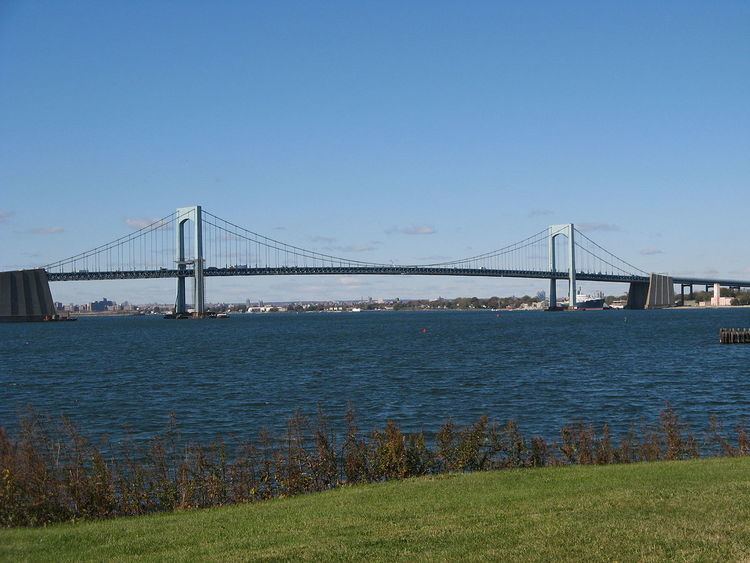Carries 6 lanes of I-295 Design Suspension bridge Address Bronx, NY 10467, USA Total length 887 m Clearance below 43 m | Longest span 1,800 feet (550 m) Construction started 22 October 1957 Height 110 m | |
 | ||
Similar Bronx–Whitestone Bridge, Triborough Bridge, Queens–Midtown Tunnel, Verrazano–Narrows Bridge, Marine Parkway–Gil Hodges | ||
Throgs neck bridge southbound 2015
The Throgs Neck Bridge is a suspension bridge opened on January 11, 1961, which carries Interstate 295 over the East River where it meets the Long Island Sound. The bridge connects the Throggs Neck section of the Bronx with the Bay Terrace section of Queens. It is the newest bridge across the East River and was built to relieve traffic on the Bronx-Whitestone Bridge 2 miles to the west, which opened in 1939. The Throgs Neck Bridge is the easternmost crossing off of Long Island. Due to this and its proximity to both the Cross Bronx Expressway and the New England Thruway, it is the closest route from Long Island to New Jersey via the George Washington Bridge; upstate New York; Connecticut; and other points north and east.
Contents
The Throgs Neck Bridge is owned by the City of New York and operated by the Triborough Bridge and Tunnel Authority, an affiliate agency of the MTA.
Throgs neck bridge southbound
History
The Throgs Neck Bridge was planned and managed by Robert Moses. His first plan for a Throgs Neck span dates back to 1945, six years after the nearby Bronx–Whitestone Bridge was completed 2 miles (3 km) to the west. This bridge was one of the few not intended for the Belt System of highways wrapping around Queens and Brooklyn. Moses commissioned famed New York City bridge designer Othmar Ammann, the man behind the George Washington, Bronx-Whitestone, Verrazano-Narrows, and Triborough bridges. This was Ammann's first long-span job after 1940, which saw the collapse of the original Tacoma Narrows Suspension Bridge in the state of Washington. Instead of employing a rather streamlined-looking plate-girder system, Ammann constructed his bridge with 28-foot-deep (8.5 m) stiffening trusses under the deck. These would weight the bridge and allow any wind to simply blow through, instead of against, the bridge.
In order to provide clearance for large ocean-going vessels Ammann added long, curved approaches to raise the span well above the low-lying shores of Bay Terrace and Throggs Neck before arching up over the water. Deck-raising began at each tower until crews met at the center, extending out to the approach viaducts. The span is 1,800 feet (549 m) long, with an anchorage to anchorage total length of 2,910 feet (887 m). The bridge was designed without non-motorized access of any kind. There are also no regularly scheduled buses. Late in the 20th century the area underneath the Queens approaches became Little Bay Park.
During planning, the bridge received the I-495 designation. During construction, the bridge became a part of I-78. Not until 1971 did the Throgs Neck Bridge become a part of I-295.
After a June 2005 inspection of the Throgs Neck Bridge, damage was found on the approach bridges, more severe away from the center median. Therefore, heavy trucks over 40 tons are permitted to use the bridge only between 11:00 p.m. and 5:00 a.m., when traffic is lightest.
On July 10, 2009 at about 5:00 a.m., a construction worker's blow torch sparked a three-alarm fire on the bridge during maintenance work to replace the deck. The fire closed the bridge for much of the day, sending traffic in both directions to the nearby Whitestone Bridge. Approximately 140 firefighters were needed to put out the fire, which lasted at least seven hours, and was fought from the scaffolding below the deck and from boats on the water. Traffic lanes on the Queens-bound side of the bridge reopened in the afternoon before the evening rush hour, but only two Bronx-bound lanes were reopened later in the evening. The third lane remained closed due to repair work for exactly a month when it reopened on August 10.
On January 11, 2011, the Throgs Neck Bridge celebrated its fiftieth year of operation.
Tolls
Starting on March 19, 2017, drivers will pay $8.50 per car or $3.50 per motorcycle for tolls by mail. E‑ZPass users with transponders issued by the New York E‑ZPass Customer Service Center pay $5.76 per car or $2.51 per motorcycle. All E-ZPass users with transponders not issued by the New York E-ZPass CSC will be required to pay cash toll/Toll-by-mail rates. The toll for five axle commercial vehicles was set at $28.40 with E-ZPass and $46.00 cash. Franchise buses are $4.17 for two axle and $4.95 with E-ZPass.
Open-road cashless tolling will begin in autumn 2017. The tollbooths will be gradually dismantled, and drivers will no longer be able to pay cash at the bridge. Instead, there will be cameras mounted onto new overhead gantries near where the booths are currently located. Drivers without E-ZPass will have a picture of their license plate taken, and the toll will be mailed to them. For E-ZPass users, sensors will detect their transponders wirelessly.
